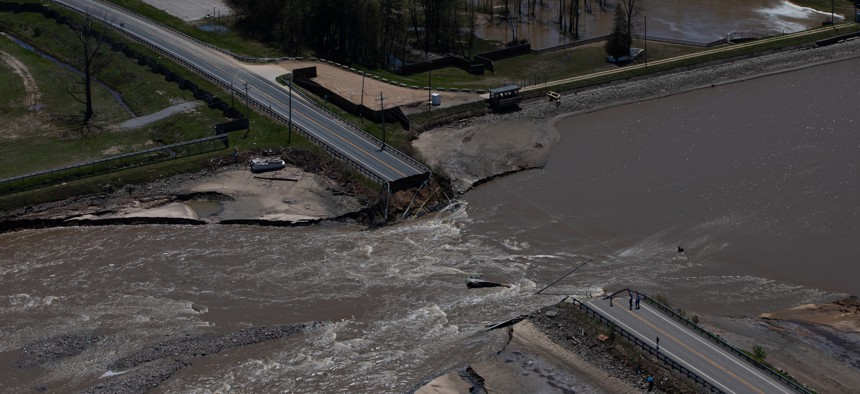Climate change is increasing stress on thousands of aging dams across the US

Collapsed road bridge in Michigan Bloomberg Creative/GettyImages
COMMENTARY | The American Society of Civil Engineers estimated that more than 2,300 high hazard potential dams—those that could cause loss of life or serious property damage if they fail—lacked emergency action plans.
This article is republished from The Conversation under a Creative Commons license. Read the original article.
Heavy rainfall in the Northeast on June 9-11, 2023, generated widespread flooding, particularly in New York’s Hudson Valley and in Vermont. One major concern was the Wrightsville Dam, built in 1935 on the Winooski River north of Vermont’s capital city, Montpelier. The reservoir behind the dam rose to within 1 foot of the dam’s maximum storage capacity, prompting warnings that water could overtop the dam and worsen already-dangerous conditions downstream, or damage the dam.
Hiba Baroud, associate professor and associate chair in the department of civil and environmental engineering at Vanderbilt University, explains how flooding stresses dams in a changing climate.
How serious is the risk when flooding overtops a dam?
Dam overtopping can result in erosion, which subsequently could lead to a dam breach or failure and a sudden, uncontrolled release of impounded water.
The risk of dam overtopping results from the combined effect of a hazardous event, such as heavy rainfall, and the vulnerability of the dam. A vulnerable dam could be old, poorly maintained or not have enough spillway capacity to safely release water from the dam.
A dam’s design can affect its ability to withstand overtopping and resist failure. For example, concrete dams can typically better withstand certain levels of overtopping compared to soil embankment dams.
Overtopping is the leading cause of dam failures in the U.S. It accounts for 34% of all dam failures. How long water flows over a dam and the volume of water that flows over it are important factors in determining the likelihood that a dam will fail.
The consequences of a dam overtopping, and possibly failing, depend on several factors, such as the purpose of the dam, its size and its location. If a dam is designed for flood protection and is surrounded by homes, businesses or critical infrastructure, a large uncontrolled release of water could be catastrophic. Dams that are small and located in rural areas may cause less damage if they are overtopped or fail.
How old are most US dams?
There are more than 91,000 dams across the U.S., in all 50 states, with diverse designs and purposes. The average dam age is 60 years, and more than 8,000 dams are over 90 years old.
Every four years, the American Society of Civil Engineers produces a report card for the nation’s infrastructure that assigns grades based on the condition of structures like roads, bridges and dams, and the investments that they need. The most recent report card estimates that 70% of U.S. dams will be more than 50 years old by 2030.
Overall, the report gave U.S. dams a “D” grade and estimated that more than 2,300 high hazard potential dams – those that could cause loss of life or serious property damage if they fail, based on the level of development around them – lacked emergency action plans.
Are there ways to strengthen older dams against flooding without completely replacing them?
Decommissioning or replacing dams can be complicated and cost-prohibitive. It also can have cascading effects on the surrounding community, and possibly on other infrastructure. Regularly maintaining and upgrading older dams can be a cost-effective way to strengthen them and make them resilient to natural hazards.
When dams no longer serve the purposes for which they were built, they may be partially breached or entirely removed to restore the river’s natural flow.
The Association of State Dam Safety Officials estimates that it would cost US$157.7 billion to rehabilitate all nonfederal dams in the U.S. Of this amount, about one-fifth ($34.1 billion) is for rehabilitating high hazard potential dams. The 2021 Infrastructure Investment and Jobs Act includes approximately $3 billion for dam safety projects, focusing on rehabilitation, retrofitting and removal.
Is climate change increasing stress on older dams?
Climate change is increasing the frequency and intensity of natural hazards like storms that threaten dams. And these shifts don’t follow historical trends. Conditions that once were considered extreme will likely be more common in the future.
For example, one recent study on predicting coastal flooding found that in New England, a 100-year flood – that’s an event of a magnitude that now has a 1% chance of occurring in any given year – could become an annual occurrence by the late 2100s.
The fact that the climate is changing also means that extreme events are becoming more extreme. In 2015, a 1,000-year rainfall event in South Carolina resulted in breaches of 47 dams.
Designing new dams and upgrading existing infrastructure will need to be based on updated design procedures that take into account future climate projections, not just historical hazardous events. While older dams aren’t necessarily unsafe, they were constructed following outdated design standards and construction procedures and for different environmental conditions. That influences the likelihood and consequences of their failure during disasters.
Do you see this event in Vermont as a warning for other communities?
The disasters that have hit the U.S. in recent years should spur government agencies and communities to prepare and plan for disasters through proactive steps such as developing emergency action plans.
While the number of high hazard potential dams in the U.S. has more than doubled in the last 20 years as development has moved farther into rural areas, the proportion of these dams with an emergency action plan has also increased. It is now at 76%, which is much higher than just a few years ago.
Vulnerable dams and the risk of dam failure cascade through our economy and affect many sectors. Dams serve many purposes: They provide water for drinking and irrigation, generate energy and protect communities from flooding. They are also part of a large navigation network that transports more than 500 million tons of commodities across the U.S. each year.
As my colleagues and I have shown, it’s important to understand the direct and indirect costs when critical infrastructure systems like dams fail. This information is crucial for developing strategies that can help the U.S. prepare for future disasters.
Hiba Baroud, is Associate Professor of Civil and Environmental Engineering, Vanderbilt University.
NEXT STORY: States have broadband money. Now they just have to figure out how to spend it.





